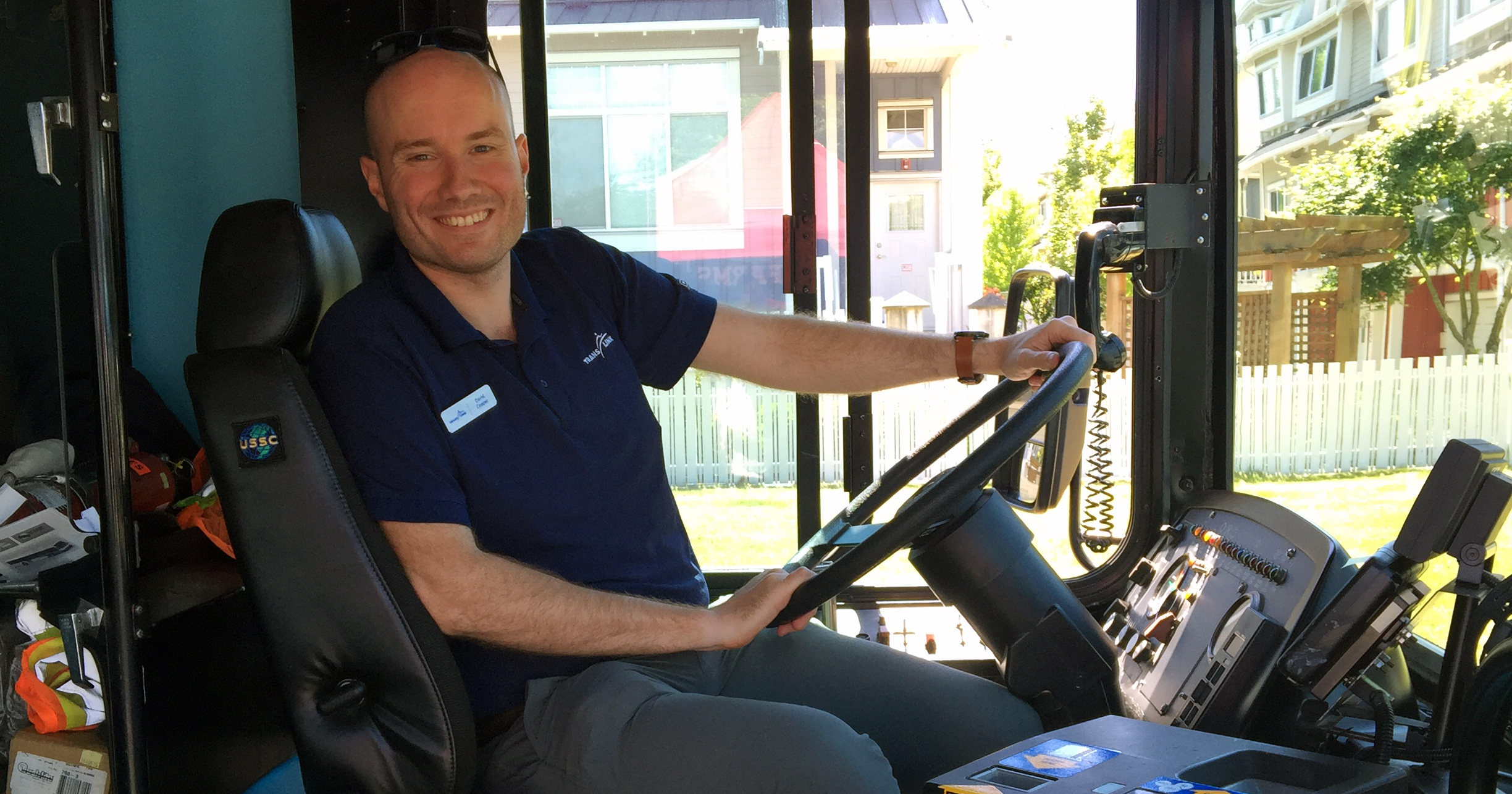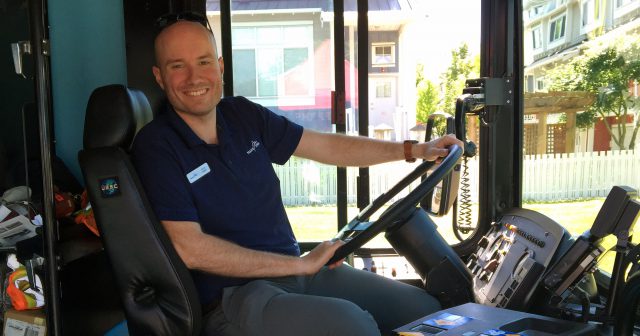Q&A: In conversation with a transit planner—TransLink and transit in Canada
Q&A: In conversation with a transit planner—TransLink and transit in Canada


Owing to TransLink’s international reputation as a progressive company in the transportation industry, our positions attract talent from across Canada and the world. Perhaps most notably, our CEO came from Seattle!
TransLink is regarded as one of the most innovative transportation companies in the world. We are unique in that we are the first North American transportation authority—and only one in Canada—to be multimodal. TransLink is responsible for the planning, financing and managing of all public transit in addition to major regional roads and bridges, transportation demand-management strategies and programs, and supporting the region’s growth strategy and regional economic development.
It was this unique challenge that spurred transit planner David Cooper to pack up and move to the Vancouver to join TransLink earlier this year as a senior planner in TransLink’s system planning department.
He came to us from Toronto where he was a senior transportation planner with the city, and prior to that, he worked for Calgary Transit.
Cooper recently sat down with The Buzzer blog to chat about working for TransLink and transit planning in Canada:
What drew you to Vancouver to work for TransLink?
I call the System Planning group the place where ideas come true at TransLink. We are advancing a vast range of projects that will forever transform our transit system. We are advancing new fleet technologies, expanding our service, and adding new rail service. In the transit world, you name it—we are probably doing it. Who wouldn’t want to work for an organization that is open to new ideas and is moving ahead projects that will make Metro Vancouver an even better place to live!
“Who wouldn’t want to work for an organization that is open to new ideas and is moving ahead projects that will make Metro Vancouver an even better place to live!”
—David Cooper on working for TransLink
TransLink is multimodal—so we’re responsible for much more than transit. Are there any challenges working under such a broad mandate?
I can only think of advantages. We can tactically coordinate our investments to improve all modes. For instance, on transit projects we can more easily work with our municipal partners to determine stop locations and transit priority measures as well as improvements to the pedestrian network, cycling infrastructure and more all at the same time. TransLink’s structure and its ability to deliver on multimodal projects have made it a leader among transportation authorities in North America.
You say TransLink’s a leader among transportation authorities in North America. What’s one thing you think TransLink excels at?
The service span and range of our Frequent Transit Network (FTN)—a network of corridors where transit service runs at least every 15 minutes in both directions throughout the day, and into the evening, seven days a week. This level of service across a whole region is rare in North America.
You can travel all the way from the University of British Columbia to Maple Ridge—a distance of more than 50 kilometres—on a Sunday and never wait more than 15 minutes for a connecting bus or train. Also, with the support of municipalities and sound land-use planning, we are seeing transit-oriented communities sprout up along many of our FTN corridors, which in turn supports transit ridership growth throughout the day.
Tell me more about the other two transit agencies that you’ve worked at.
I worked at Calgary Transit first as an intern, then as a planner and later as a senior planner. There I worked on the implementation of two different bus rapid transit (BRT) projects, most notably the Airport BRT. I also worked on the opening of two extensions to Calgary’s LRT system, the CTrain, and the launch of Calgary’s first regional transit service, the Airdrie InterCity Express (ICE). Most recently, I worked for the City of Toronto, where for three years on subway expansion projects jointly with the Toronto Transit Commission such as the Relief Line.
“TransLink’s structure and its ability to deliver on multimodal projects have made it a leader among transportation authorities in North America.”
—David Cooper on TransLink
Are there are commonalities between these agencies and TransLink?
The main similarity is that three agencies are advancing many transformative projects right now, mainly due to favorable funding programs from the three levels of governments.
In Calgary, their new enhanced BRT network is opening next year and the Green Line LRT project coming down the pipeline. Toronto is rolling out a new streetcar fleet, constructing new LRT lines and more.
Here, TransLink is advancing two significant rapid transit projects as part of the Mayors’ Council’s 10-Year Vision: the Millennium Line Broadway Extension and Surrey LRT projects. As well, increased transit service, better roads, safer cycling and pedestrian access is also coming through Phase One of the 10-Year Vision.
From a planning perspective, what’s one area both the Calgary Transit and the Toronto Transit Commission have done really well in?
Both transit agencies have done a great job of investing in all-day high-quality express bus services to help build strong transit corridors for future rapid transit expansion. In Calgary, two Bus Rapid Transit corridors (Routes 301 and 302) have been tagged to transition LRT service (Calgary’s Green Line LRT). At the end of this year, the TTC will be opening the Toronto-York Spadina Subway Extension to key destinations such as York University, replacing their very successful 196 York University Rocket service.
In your opinion, what’s one thing TransLink can learn from its peers?
The BRT services in Toronto run along the York University Busway, a series of bus-only lanes and roads, whereas Vancouver’s B-Line service currently mixes in with regular traffic, which affects reliability and efficiency.
As part of Phase One of the 10-Year Vision, TransLink added the 95 B-Line along Hastings Street and four more B-Line routes are coming on Fraser Highway, Lougheed Highway, Marine Drive and 41st Avenue by 2019.
For improved customer experience, including better speed and reliability, TransLink is working with municipalities to determine feasibility of implementing service features found on systems like the one in Toronto: transit priority lanes, transit signal priority, real-time next-bus information and enhanced shelters and information at B-Line stops, and stronger branding and identification of B-Line service.
In closing, what is a challenge all transit agencies are grappling with?
A big challenge is a lot of time and energy placed publicly and politically on expansion projects such as new LRT and subway lines. What’s harder to sell, though, is the importance of keeping your system in a state of good repair such as station improvements and replacement fleets—it’s not as sexy as building brand new lines.
The existing rail systems in both Calgary and Toronto are both very well utilized in terms of ridership—which is great, but the stations and fleet are aging. For instance, almost half of Calgary’s CTrain LRT fleet is still the original cars from the early 1980s.
Fortunately, we have seen increased funding for projects from our government partners to help to renew facilities that are helping out ensuring service reliability. A replacement fleet for the CTrain is now arriving and the same is true for Toronto’s streetcars.
At TransLink, the federal Gas Tax Fund is helping refurbish 114 original Mark I SkyTrain cars purchased when the system opened. As well, as part of Phase One of the 10-Year Vision, TransLink is purchasing new buses to expand the fleet, replacement buses to maintain and modernize the fleet, a new SeaBus vessel as well as new rail cars for the Expo, Millennium and Canada lines, and West Coast Express.
Thanks your insight, David! We look forward to hearing more from you in the future.
Author: Allen Tung






Hi there … I’m working on a project in King County and wanted to reach out to David to ask if Vancouver has had any similar projects I could view as examples please. It’s fine for him to connect by email and my work phone is 206.263.0929. Thank you, Grace
Hi Grace, I’ve passed along your phone number and email to David.